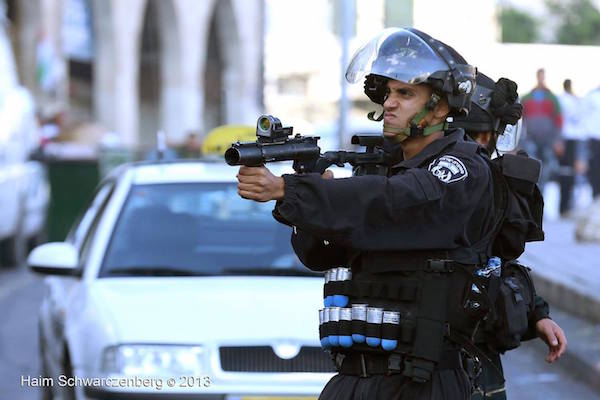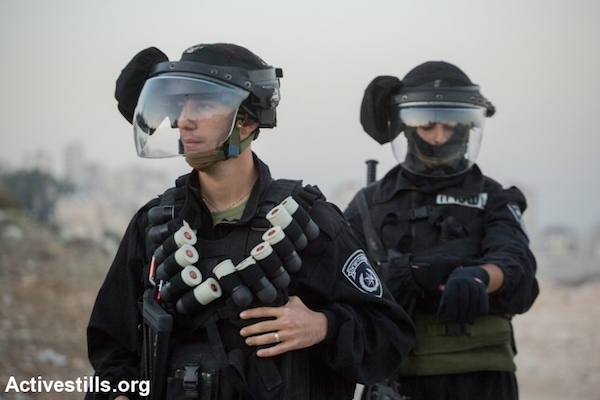A new type of sponge-tipped bullet introduced in East Jerusalem last summer has broken arms, fractured faces, destroyed eyesight and killed a teenager. Now a similar projectile is slated for use against Palestinians in the West Bank.

Following the introduction last summer of a new type of sponge-tipped bullet into the Israel Police’s arsenal, the Israeli army is now set to begin using a similar projectile in order to disperse demonstrations in the West Bank, according to Ynet [Heb]. The new bullets will be phased in during the coming weeks as a pilot, following which they will be distributed among routine army units.
The debut of the new black sponge-tipped bullets in Jerusalem brought with it facial fractures, broken arms, eye loss (predominantly among children) and at least one death. The bullets are a harder version of the blue sponge-tipped bullets previously used by police; made out of heavier material (synthetic rubber), they are far more likely to cause serious injury.
The army officer interviewed in Ynet’s report claimed that the new bullets for the IDF have been purchased from a different manufacturer to those used by the Israel Police, and have undergone more rigorous testing. The officer further asserted that their new sponge-tipped bullets are less dangerous than those deployed in East Jerusalem.
However, the Association for Civil Rights in Israel (ACRI) has thrown this claim into doubt. ACRI attorney Anne Suciu stated that the army’s new sponge-tipped bullets will be “at least as hard as those used by the police.” Although they will be blue — the same color as the old, softer bullets — they are weapons of a different grade, as the original blue sponge-tipped bullets have been deemed “ineffective” in dispersing protests.
Suciu further confirmed that the sponge-tipped bullets will eventually replace rubber bullets in the West Bank, a transition that had originally been planned for the end of 2013. Regarding the army officer’s claim to Ynet that they are a “more humane” means of breaking up demonstrations, Suciu explained that although this is technically correct, the irregular use of such projectiles — e.g. firing them at the upper body, as has consistently occurred in East Jerusalem — renders them far more dangerous than they are supposed to be.
Read: Losing sight of the consequences of ‘less-lethal’ weapons
In that vein, ACRI on Thursday issued its second appeal [Heb] in as many months for the police to immediately suspend the use of the black sponge-tipped bullets until their safety had been fully investigated (both letters were written by Suciu). Responding to a request from the Legal Advisor to the Israel Police for all information they hold relating to injuries caused by the black sponge-tipped bullets, ACRI also passed on statistics provided by the UN Office for the Coordination of Humanitarian Affairs (OCHA).
OCHA reports that between June 1st and December 31st 2014, 1,003 Palestinians in East Jerusalem required medical treatment for injuries caused by sponge-tipped bullets. While OCHA refers to “rubber bullets” in its statistics, ACRI clarifies in the letter that they do not know of any use of such projectiles in East Jerusalem, and therefore conclude that the report relates to sponge-tipped bullets (OCHA’s statistics correspond to the date of the introduction of these weapons into the Israel Police’s arsenal).

Of the 1,003 cases cited, 144 of the injured were evacuated to hospital; at least 47 of those had been shot in the upper part of their body, in contravention of the regulations governing the police’s use of these bullets.
ACRI discovered in March that the black sponge-tipped bullets had been in use for six months before guidelines on their use were issued and training was conducted. However, these measures seem to have done little to reduce the number of serious injuries caused: on Thursday afternoon, the day of ACRI’s letter, yet another Palestinian child was shot in the eye near Shuafat Refugee Camp. The condition of the 10-year-old’s eye is currently unknown.
The introduction of a new weapon into the West Bank is always cause for serious concern, but is even more alarming when its use has already produced such devastating consequences. Although the army officer interviewed by Ynet insisted that the sponge-tipped bullets represent a less-damaging method of crowd control, the wider context of the current situation of army and police violence at West Bank protests cannot be ignored.
From increasing the use of live ammunition to firing tear gas canisters directly at protesters and attacking photojournalists, Israeli security forces have been stepping up their means of suppressing demonstrations. In such an environment, declarations of concern for civilian life (especially when juxtapositioned competitively against that of the police, as the army officer in Ynet’s article has bizarrely done) are questionable.
Furthermore, any IDF claim as to the “less-lethal” nature of their weapons is contingent upon their use in accordance with army regulations, rules that are consistently flouted. As B’Tselem has reported, rubber-coated steel bullets, tear gas and 0.22-caliber live ammo — all supposedly “non-lethal” means of dispersing demonstrations — have killed numerous Palestinians over the years, primarily due to irregular use.
Despite how the army is framing the introduction of their new weapon, we are likely to see a spike in the type of injuries that have so blighted East Jerusalem over the last year.


